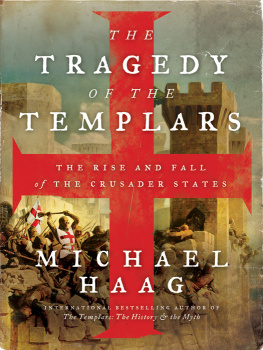IN DISTANT LANDS
A Short History of the Crusades
Lars Brownworth

For Catherine
Contents
CAST OF CHARACTERS
The First Crusade: The Peoples Crusade (Chapters 1-2)
Alexius I Comnenus: Byzantine emperor whose appeal for help to Urban II resulted in the First Crusade
Emicho: Count of Leiningen and leader of the anti-Semitic German Crusade
Kilij Arslan: Turkish sultan based in Nicaea
Peter the Hermit: French priest, main leader of the Peoples Crusade. Also known as Peter of Amiens
Urban II: The pope whose speech at Clermont in 1095 launched the First Crusade
Walter Sans-Avoir: Lord of Boissy-sans-Avoir, minor leader of the Peoples Crusade. Also known as Walter the Penniless
The First Crusade: The Princes Crusade (Chapters 3-6)
Adhemar of Le Puy: Papal legate, spiritual leader of the First Crusade
Baldwin: Brother of Godfrey of Bouillon. Founded the first crusader state (Edessa), second King of Jerusalem
Bohemond: Prince of Taranto, founded the second crusader state (the Principality of Antioch)
Godfrey: Duke of Lower Lorraine, first (uncrowned) King of Jerusalem with the title Defender of the Holy Sepulcher
Hugh of Vermandois: Younger brother of the King of France, first major noble to leave on Crusade
Kerbogah: Atabeg of Mosul
Peter Bartholomew: French mystic who had a vision of the Holy Lance at Antioch
Raymond: Count of Toulouse, major rival of Bohemond
Stephen of Blois: Son-in-law of William the Conqueror
Tancred: Nephew of Bohemond, later Prince of Galilee and regent of Antioch
Taticius: Byzantine general who traveled with the crusaders to Antioch
Yaghi-Siyan: Turkish governor of Antioch
Formation of Outremer (Chapters 7-9)
Baldwin II: Cousin of Baldwin I, third King of Jerusalem. Also known as Baldwin of Le Bourg
Baldwin III: Son of Fulk and Melisende, fifth King of Jerusalem
Daimbert: Papal legate appointed to succeed Adhemar of Le Puy
Domenico Michele: Doge of Venice
Fulk of Anjou: Husband of Melisende, fourth King of Jerusalem
Hugh of Payns: French knight who founded the Knights Templar
Joscelin II: Count of Edessa whose rivalry with Raymond of Poitiers led to the fall of the County of Edessa
Melisende: Daughter of Baldwin II who ruled with her husband Fulk as regent for their son Baldwin III
Raymond of Poitiers: Prince of Antioch and uncle of Eleanor of Aquitaine
Zengi: Emir of Aleppo whose victories precipitated the Second Crusade
Second Crusade (Chapters 10-11)
Bernard of Clairvaux: Cistercian monk, responsible for the Second Crusade
Conrad III: Holy Roman Emperor
Eleanor of Aquitaine: Wife of Louis VII and niece of Raymond of Poitiers
Eugenius III: Pope who called the Second Crusade
Louis VII: King of France, first major figure to take the crusading oath
Manuel Comnenus: Byzantine Emperor, grandson of Alexius I Comnenus
Nr al-Dn: Emir of Aleppo, son of Zengi
Third Crusade (Chapters 12-15)
Amalric: younger brother of Baldwin III, sixth King of Jerusalem
Baldwin IV: Son of Amalric, seventh King of Jerusalem. Also known as the Leper King
Frederick Barbarossa: Holy Roman Emperor, nephew of Conrad III
Gregory VIII: Pope who called the Third Crusade
Guy of Lusignan: French noble, ninth King of Jerusalem
Henry II: King of England, second husband of Eleanor of Aquitaine
Isaac Angelus: Byzantine Emperor during the Third Crusade
Philip II Augustus: King of France, son of Louis VII
Reynald of Chtillon: Prince of Antioch whose reckless behavior led to the loss of Jerusalem
Richard the Lionheart: King of England, son of Henry II and Eleanor of Aquitaine. The major figure of the Third Crusade
Saladin: Son of Shirkuh, reconquered Jerusalem for Islam
Shirkuh: Kurdish general of Nr al-Dn who made himself vizier of Egypt
Tancred of Lecce: King of the Norman Kingdom of Sicily. Also known as the Monkey King
Fourth Crusade (Chapter 16)
Alexius III Angelus: Byzantine Emperor, younger brother of Isaac II
Alexius IV Angelus: Byzantine Emperor, son of Isaac II, allied with the crusaders
Alexius V: Byzantine Emperor, overthrew Alexius IV. Also known as Mourtzouphlos
Boniface: Marquess of Montferrat, leader of the Fourth Crusade
Enrico Dandolo: Doge of Venice, leader of the Fourth Crusade
Innocent III: Pope who called the Fourth and Fifth Crusades
Isaac II Angelus: Byzantine emperor, overthrown by Alexius III just before the Fourth Crusade was called
Thibaut: Count of Champagne, nephew of Richard the Lionheart
Fifth Crusade (Chapter 17)
al-Kamil: Sultan of Egypt during the Fifth, Sixth, and Seventh Crusades, nephew of Saladin
Andrew: King of Hungary, leader of the Fifth Crusade
Frederick II Barbarossa: Holy Roman Emperor. Also known as Stupor Mundi
John of Brienne: Regent of Jerusalem, leader of Fifth Crusade
Leopold: Duke of Austria, leader of the Fifth Crusade
Nicholas of Cologne: German shepherd boy, one of the leaders of the Childrens Crusade
Pelagius: Papal legate, leader of the Fifth Crusade
Sixth Crusade (Chapter 18)
Frederick II Barbarossa: Holy Roman Emperor, leader of the Sixth Crusade
Gregory IX: Pope who succeeded Honorius III, excommunicated Frederick II
Honorius III: Pope who called the Sixth Crusade
Yolande: Daughter of John of Brienne, heir to throne of Jerusalem
Seventh and Eighth Crusades (Chapters 19-21)
Baybars: Mamluk sultan of Egypt
Charles of Anjou: Brother of Louis IX, King of Sicily
Edward I: King of England who joined the Eighth Crusade after it had officially ended. Led what is sometimes called the Ninth Crusade. Also known as Longshanks
Hulagu: Grandson of Ghengis Khan, leader of the Mongols
Innocent IV: Pope during the Seventh Crusade
Louis IX: King of France, leader of the Seventh and Eighth Crusades. Also known as Saint Louis
Prester John: Legendary Christian kingof the East
Robert of Artois: Brother of Louis IX
- LIST OF MAPS
- 1. The Byzantine Empire
- 2. The Abbasid Islamic Empire c. 750
- 3. The Route of the First Crusade
- 4. The Crusader States c. 1135
- 5. The Route of the Fourth Crusade
"Si vis pacem, para bellum"
Publius Flavius Vegeitus
Prologue: Yarmouk
In the early months of the year 636, an army mounted on camels crossed the Syrian border and in what appeared to be a suicidal attack invaded the Eastern Roman Empire. This state, better known as Byzantium, was the glittering, cultured bulwark of Christendom, whose borders stretched from the Atlantic coast of southern Spain in the west, to the deserts of modern Saudi Arabia in the east. On every side, the empire seemed ascendant. After four centuries of intermittent war, Romes ancient enemy Persia had finally been defeated, decisively smashed by the brilliant Roman soldier-emperor Heraclius.














